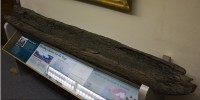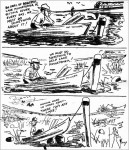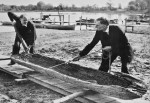 New radiocarbon dating results have found that a Native American dugout canoe discovered in Lake Minnetonka southwest of Minneapolis-Saint Paul, Minnesota, in 1934 is nearly 1,000 years old, making it the oldest dugout canoe ever found in Minnesota. It was thought to date to around 1750 and even though it was in excellent condition it wasn’t considered an archaeological superstar. That’s all changed now.
New radiocarbon dating results have found that a Native American dugout canoe discovered in Lake Minnetonka southwest of Minneapolis-Saint Paul, Minnesota, in 1934 is nearly 1,000 years old, making it the oldest dugout canoe ever found in Minnesota. It was thought to date to around 1750 and even though it was in excellent condition it wasn’t considered an archaeological superstar. That’s all changed now.
 The canoe was discovered by Helmer Gunnarson and his brother Arthur when they were building an extension to their dock on the North Arm of Lake Minnetonka in August of 1934. It was a record dry year — the water level was seven feet below normal — and the shoreline had receded significantly. While sinking a dock piling 90 feet from the shore, Helmer and Arthur encountered an obstacle about a foot under the lake floor. At first they thought it was a log, but when they dug it out and dragged it to shore, they saw it was a dugout canoe. They noted it was in excellent condition, preserved by years under the silt and several feet of lake water.
The canoe was discovered by Helmer Gunnarson and his brother Arthur when they were building an extension to their dock on the North Arm of Lake Minnetonka in August of 1934. It was a record dry year — the water level was seven feet below normal — and the shoreline had receded significantly. While sinking a dock piling 90 feet from the shore, Helmer and Arthur encountered an obstacle about a foot under the lake floor. At first they thought it was a log, but when they dug it out and dragged it to shore, they saw it was a dugout canoe. They noted it was in excellent condition, preserved by years under the silt and several feet of lake water.
 The Gunnarsons reached out to the University of Minnesota and the Minnesota Historical Society to examine the canoe, but wound up donating it to the Minnesota Archaeological Society, who generously gifted their father Gustave with an honorary membership in response. The MAS loaned the canoe for display at the Minneapolis Institute of Arts and the Minneapolis Public Library and exhibited it at the Walker Art Gallery along with some of their other artifacts. In 1961, they sold it to the Western Hennepin County Pioneer Association museum in Long Lake, Minnesota, who added it to the museum’s eclectic collection of artifacts including a moose once shot by Theodore Roosevelt.
The Gunnarsons reached out to the University of Minnesota and the Minnesota Historical Society to examine the canoe, but wound up donating it to the Minnesota Archaeological Society, who generously gifted their father Gustave with an honorary membership in response. The MAS loaned the canoe for display at the Minneapolis Institute of Arts and the Minneapolis Public Library and exhibited it at the Walker Art Gallery along with some of their other artifacts. In 1961, they sold it to the Western Hennepin County Pioneer Association museum in Long Lake, Minnesota, who added it to the museum’s eclectic collection of artifacts including a moose once shot by Theodore Roosevelt.
 It was in its display in a hallway of the WHCPA museum that Maritime Heritage Minnesota archaeologists Ann Merriman and Chris Olson first encountered the canoe. They secured a $9,000 grant from the state to radiocarbon date and study the Lake Minnetonka canoe and seven other canoes discovered in Minnesota. The study did turn up some bad news. The canoe has deteriorated over time. The ends are frayed and the sides lower than they used to be. There is a long crack that splits the craft’s entire 11-foot length, a crack that was not there in 1934 as historical pictures confirm. Fragments of wood have come off and litter the hull.
It was in its display in a hallway of the WHCPA museum that Maritime Heritage Minnesota archaeologists Ann Merriman and Chris Olson first encountered the canoe. They secured a $9,000 grant from the state to radiocarbon date and study the Lake Minnetonka canoe and seven other canoes discovered in Minnesota. The study did turn up some bad news. The canoe has deteriorated over time. The ends are frayed and the sides lower than they used to be. There is a long crack that splits the craft’s entire 11-foot length, a crack that was not there in 1934 as historical pictures confirm. Fragments of wood have come off and litter the hull.
 The good news is those fragments made sampling the wood for typing and dating a simple matter of picking up a few of them. The radiocarbon dating found the wood sample dates to 1025-1165 A.D., the Final Late Woodland Period of the Woodlands Culture. The report of the Maritime Heritage Minnesota study has now been published and can be read in its entirety here).
The good news is those fragments made sampling the wood for typing and dating a simple matter of picking up a few of them. The radiocarbon dating found the wood sample dates to 1025-1165 A.D., the Final Late Woodland Period of the Woodlands Culture. The report of the Maritime Heritage Minnesota study has now been published and can be read in its entirety here).
Now that the canoe’s true historical value has been identified, it must be properly conserved to prevent further deterioration.
In Long Lake, the canoe that once was relegated to a corner is now the museum’s centerpiece — fitting, since it’s about 6 miles from where it was discovered. The museum will rope it off and enclose it in a glass case with updated details about how rare and old it is.
“We’ll never loan it again, especially now we know what it is,” [Russ Ferrin, the volunteer who runs the Pioneer Museum,] said.
It’s not just newfound fame for an ancient artifact but also for the small museum. Founded by pioneers 107 years ago, the nonprofit is housed in an old school building. It’s run by Ferrin and other volunteers, and admission is free when it’s open for four hours on Saturdays.
“It is [the main attraction] now,” Ferrin said of the canoe. “We hope it will draw visitors.”
I’ll add that I hope it draws lots of donations too, to ensure it can be kept in a humidity controlled environment and properly conserved for future generations.